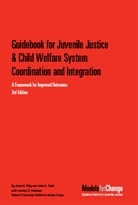Dual status youth move between the child welfare and juvenile justice systems, and often are involved in both concurrently. They are disproportionately youth of color and girls, and many have histories of abuse and neglect. Absent interventions, these youth are at increased risk for mental health concerns, educational problems, occupational difficulties, and public health and safety issues. Despite being served by two systems, these youth often fall through the cracks.
Through its Resource Center Partnership, Models for Change supports the kind of coordinated, multi-system integration that improves outcomes for dual status youth. Led by the Robert F. Kennedy Children’s Action Corps, the initiative-supported RFK National Resource Center for Juvenile Justice uses proven models and tools as well as the best available research to serve leaders and practitioners at all levels to: build capacity for addressing the unique needs of dual status youth, coordinate and integrate child-serving systems, and improve juvenile probation systems.
Models for Change supports coordinated, multi-system interventions to improve outcomes for youth in the juvenile justice and child welfare systems.
Featured publications
Initiative tools, research, knowledge, and innovations to promote reform
-
 From Conversation to Collaboration: How Child Welfare and Juvenile Justice Agencies Can Work Together to Improve Outcomes for Dual Status Youth
From Conversation to Collaboration: How Child Welfare and Juvenile Justice Agencies Can Work Together to Improve Outcomes for Dual Status Youth
- May 8, 2014, RFK National Resource Center for Juvenile Jusitce
- Dual status youth cross the agency lines of the juvenile justice and child welfare systems, yet the agencies do not always communicate or collaborate on plans to serve the youth. Research and…
-
 Guidebook for Juvenile Justice & Child Welfare System Coordination and Integration: A Framework for Improved Outcomes, 3rd Edition
Guidebook for Juvenile Justice & Child Welfare System Coordination and Integration: A Framework for Improved Outcomes, 3rd Edition
- Dec 13, 2013, Janet K. Wiig and John A. Tuell
- Increasingly, practitioners and policymakers are recognizing the overlap of the child welfare and juvenile justice systems. This overlap is evidenced by maltreated children who become juvenile…
-
 Dual Status Youth – Technical Assistance Workbook
Dual Status Youth – Technical Assistance Workbook
- Dec 1, 2013, John A. Tuell
- “Dual status youth” refers to juveniles who come into contact with both the child welfare and juvenile justice systems and occupy various statuses in terms of their relationship to the…
-
 Information Sharing Tool Kit-Second Edition
Information Sharing Tool Kit-Second Edition
- Jan 20, 2015, Juvenile Law Center and Robert F. Kennedy National Resource Center for Juvenile Justice
- The Tool Kit website is designed to assist jurisdictions in creating and implementing information and data sharing initiatives to achieve better outcomes for youth involved in the juvenile justice…
More publications »
Leading organizations
Network partners advancing reforms and providing assistance, lessons, and support
- Robert F. Kennedy Children’s Action Corps
- (617) 227-4183
More contacts »
Share